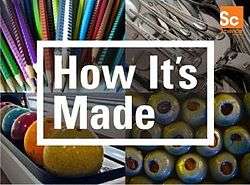How It's Made
| How It's Made | |
|---|---|
 | |
| Created by | Gabriel Hoss |
| Presented by |
|
| Country of origin | Canada |
| Original language(s) | English |
| No. of seasons | 30 |
| No. of episodes | 396 (list of episodes) |
| Production | |
| Running time | 30 minutes (including commercials) |
| Release | |
| Original network |
Z (Quebec) Discovery Science (Canada) Science (United States) Discovery Channel (United States) Discovery Channel (Canada) Quest (United Kingdom) |
| Picture format |
480i (SDTV) (2001-2009) 1080i (HDTV) (2009-present) |
| Original release | January 6, 2001 – present |
| External links | |
| Website | |
How It's Made (Comment c'est fait in Quebec) is a documentary television series that premiered on January 6, 2001, on the Discovery Channel in Canada, and Science in the United States. The program is produced in the Canadian province of Quebec by Productions MAJ, Inc. and Productions MAJ 2.[1]
Format
The show is a documentary showing how common, everyday items (including clothing and accessories like alligator handbags, foodstuffs like bubble gum, industrial products such as engines, musical instruments such as guitars, and sporting goods such as snowboards) are manufactured.
How It's Made is filmed without explanatory text to simplify overdubbing in different languages. For example, the show currently avoids showing a narrator or onscreen host, does not often have employees of featured companies speak on camera, and keeps human interaction with the manufacturing process to a bare minimum.
An off-screen narrator explains each process, often with humorous puns. Each half-hour show usually has three or four main segments, with each product getting a demonstration of approximately five minutes; exceptions are allowed in the allotted time for more complex products. Usually, every show has at least one product with a historic background note preceding it, showing how and where the product originated, and what people used before it.
In April 2007, all episodes run in the United States (on the Discovery Channel and Science) had the individual season openings replaced with a new opening used for every episode. Similar to most other Discovery Channel shows, the credits now run during the last segment, with only a blue screen and the request for feedback (and the website) at the end.
In September 2007, the ninth season began airing on Science, along with new openings, graphics, and soundtracks, and Zac Fine replaced Brooks T. Moore as the narrator. However, the eleventh season, which started airing in September 2008, reinstated Moore as the narrator and reverted to a previous title sequence and soundtrack.
In June 2008, the Science Channel added How It's Made: Remix, which consists of previous segments arranged into theme installments like "Food", "Sporting Goods", and such. In 2013, the Science Channel added How It's Made: Dream Cars, which focused exclusively on high-performance and exotic cars.[2] These were later shown on the Velocity channel.
Hosts
Canadian hosts have included Mark Tewksbury (season 1, 2001), Lynn Herzeg (seasons 2–4, 2002–2004), June Wallack (season 5, 2005) and Lynne Adams (season 6 onwards, 2006–present).
A different voice-over track is recorded for US audiences by Brooks Moore (seasons 1–8, 2001–2007, 2008–present) and Zac Fine (2007–2008). The scripts are almost identical but the main difference in the US versions are that the units of measurement are given in United States customary units instead of metric units. At one point in the US run, a subtitled conversion was shown on-screen over the original narration.
In the United Kingdom, the rest of Europe, and in some cases in Southeast Asia, the series is narrated by Tony Hirst.
Episodes
Critical reception
Common Sense Media gave the TV show a rating of 4/5 stars, writing "Curious kids and adults will learn from the show, and some segments can really broaden your perspective".[3] On the show's success despite its formulaic nature, Rita Mullin, the general manager of the Science Channel, said "I think what is one of the great appeals of the show as a viewer myself is how little has changed over the years".[4] The Wall Street Journal deemed it "TV's quietest hit".[5]
Accolades
| Year | Award | Category | Recipient(s) | Result | Ref. |
|---|---|---|---|---|---|
| 2014 | Young Artist Award | Social Relations of Knowledge Institute Award | How It's Made | Awarded | [6] |
Parodies
The series was spoofed in an episode of Rick and Morty in a segment where a "Plumbus" was being made[7], and again in a Captain Disillusion video showing how hoax UFO videos are made[8].
See also
References
- ↑ 3959015 Canada, Inc.
- ↑ "How It's Made: Dream Cars". Science. Archived from the original on June 18, 2013.
- ↑ "How It's Made: TV Review". Common Sense Media.
- ↑ Eveleth, Rose (November 13, 2014). "How How It's Made Is Made". The Atlantic.
- ↑ Jurgensen, John (December 18, 2014). "How It's Made: TV's Quietest Hit". The Wall Street Journal.
- ↑ "35th Annual Young Artist Awards". Young Artist Awards. Retrieved April 14, 2014.
- ↑ Blevins, Joe (June 6, 2016). "Rick And Morty shows how a plumbus is made, in almost too-graphic detail". The AV Club. Retrieved July 16, 2016.
- ↑ CaptainDisillusion (2015-12-31), UFO Over India DEBUNK, retrieved 2017-11-11
External links
- "How It's Made - Watch Online". Discovery.
- "How It's Made". Discovery Science. December 10, 2013.
- "How It's Made | Facebook". www.facebook.com.
- How It's Made at TV.com